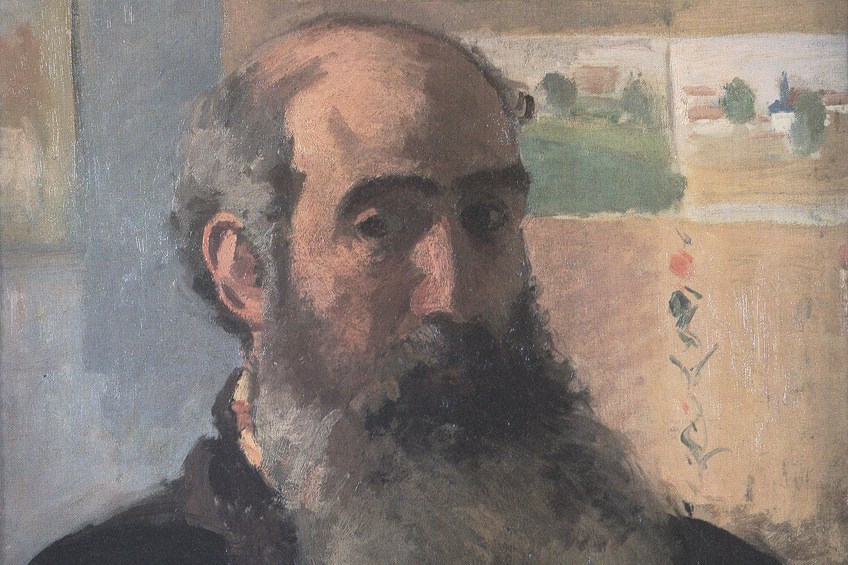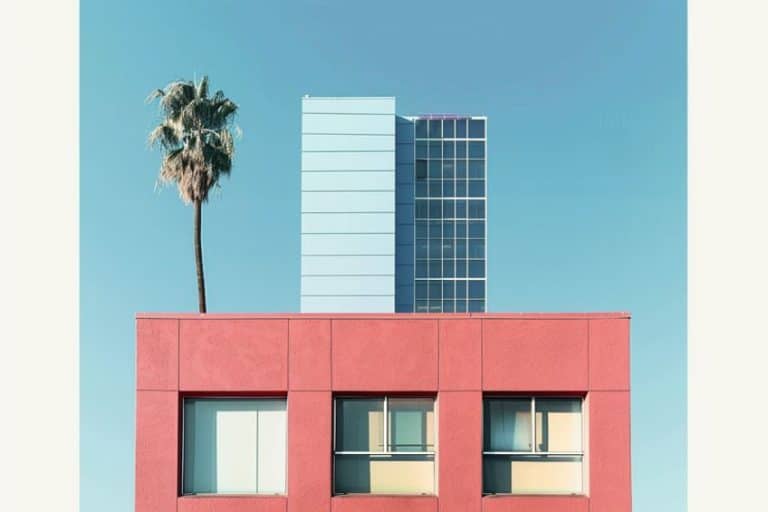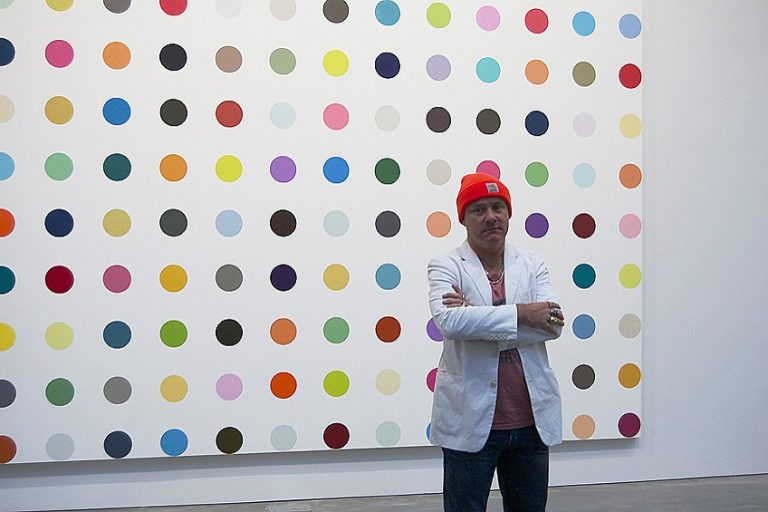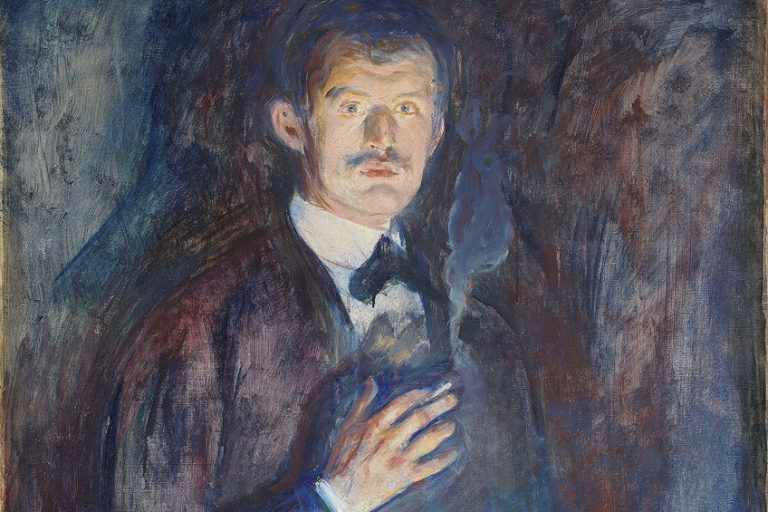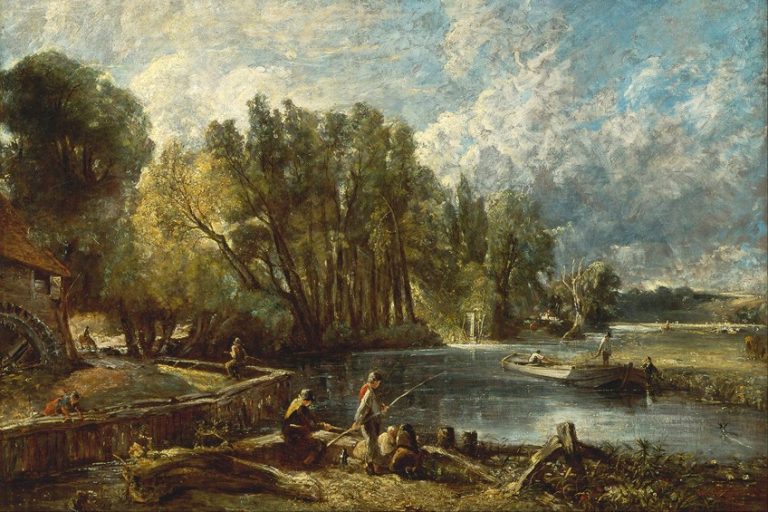Camille Pissarro – Influential Impressionist and Neo-Impressionist
Although Camille Pissarro is not as well-known as other Impressionists such as Cézanne and Monet this does not mean that his contributions to the movement were any less great. In fact, many of these younger Impressionists were mentored by him. Through his dedication to the Impressionist movement, he earned the nickname “The father of Impressionism”. The life and works of this phenomenal artist will be explored in the article below.
Artist in Context: Who Was Camille Pissarro?
Who was Camille Pissarro and why is he so important in the history of art? In this article, we will explore the answer to this question. The Danish-French artist was highly influential during the 19th century and has a vast collection of works. He was forever growing as an artist and experimented with many different art styles throughout his career. Enjoy a peek at the life and artworks of Camille Pissarro.
| Date of Birth | 10 July 1830 |
| Date of Death | 13 November 1903 |
| Country of Birth | St Thomas, U.S Virgin Islands |
| Art Movements | Impressionism, Post-Impressionism |
| Genre/ Style | Cityscape, Landscape, Portrait |
| Mediums Used | Painting, Drawing |
| Dominant Themes | Nature, Peasants |
The Birth and Early Life of Camille Pissarro
Jacob Abraham Camille Pissarro was born on 10 July 1830, on the island of St Thomas. During Pissarro’s lifetime, St Thomas made up part of the Danish West Indies. However, as of 1917, it came under the ownership of the United States. Pissarro’s father, Frederick Abraham Gabriel Pissarro, moved from France to St Thomas to take over a hardware business left to him by his late uncle. After arriving on the island, Frederick married Rachel Pomié Petit, his uncle’s widow. Their marriage was disapproved of by the small community of St Thomas, although this did not stop them from starting a family.
Pissarro and his three siblings were raised in a traditional Jewish household. However, he never alluded to this in any of his works and later in life proclaimed himself to be an atheist.
Yet, he never denied his Jewish heritage, even though at that time anti-Semitism was rife. During the scandal of the Dreyfus affair, Pissarro took a pro-Dreyfus stance. This was primarily due to his anti-bourgeois beliefs, however, many accredited it to his Jewish background. It was for this reason that many of his former friends and colleagues, such as Renoir, turned against him.

Pissarro and all of his siblings received their primary school education at St Thomas. However, upon turning 12, he was sent off to boarding school in France. He attended the Savary Academy in Passy, not far from Paris. It was here that his love of art developed.
The headmaster of the school, Monsieur Savary, personally noticed Pissarro’s natural talent and encouraged him to practice drawing and painting.
At the age of 17, Pissarro returned to St Thomas. He took the opportunity to practice his artistic skills by sketching and painting his surroundings. But his father did not want him to be an artist, forcing him to work in his shop instead. Pissarro obeyed, although he practiced drawing during any spare moment he could. After five years of working for his father, Danish artist Fritz Melbye took Pissarro under his wing. The two of them moved to Venezuela, where they painted the landscapes of Caracas and La Guaira.
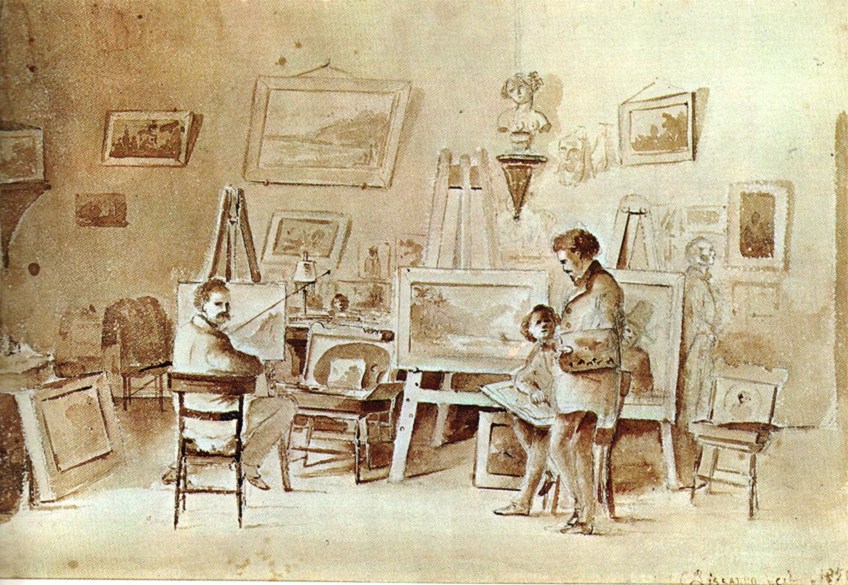
Education and Career
In 1855, Pissarro returned to France to work as an artist’s assistant for Fritz’s brother, Anton Melbye. He also took advantage of the numerous art institutions in Paris, attending the famous École des Beaux-Arts and the Académie Suisse. It was here that he met artists such as Claude Monet, Paul Cézanne, and Armand Guillaumin. The artists would form a friendship based on their joint appreciation for nature and landscape painting. They were also all vocally opposed to the inflexible rules of the Paris Salon.
Pissarro received private training from some of the great French masters, including Corot, Courbet, and Daubigny.
He and Corot had a particularly good work relationship, with Corot having been recognized as having had a large influence on many of Pissarro’s early works. It was Corot who taught him to paint en plein air, thus Pissarro spent most of his time painting in the countryside near Paris. However, unlike Corot, who would create a basic painting en plein air and then finish it in his studio, Pissarro preferred to complete the painting whilst there. This gave his paintings a sense of realism. It was also the reason many criticized his paintings, saying they were too raw and not refined enough.
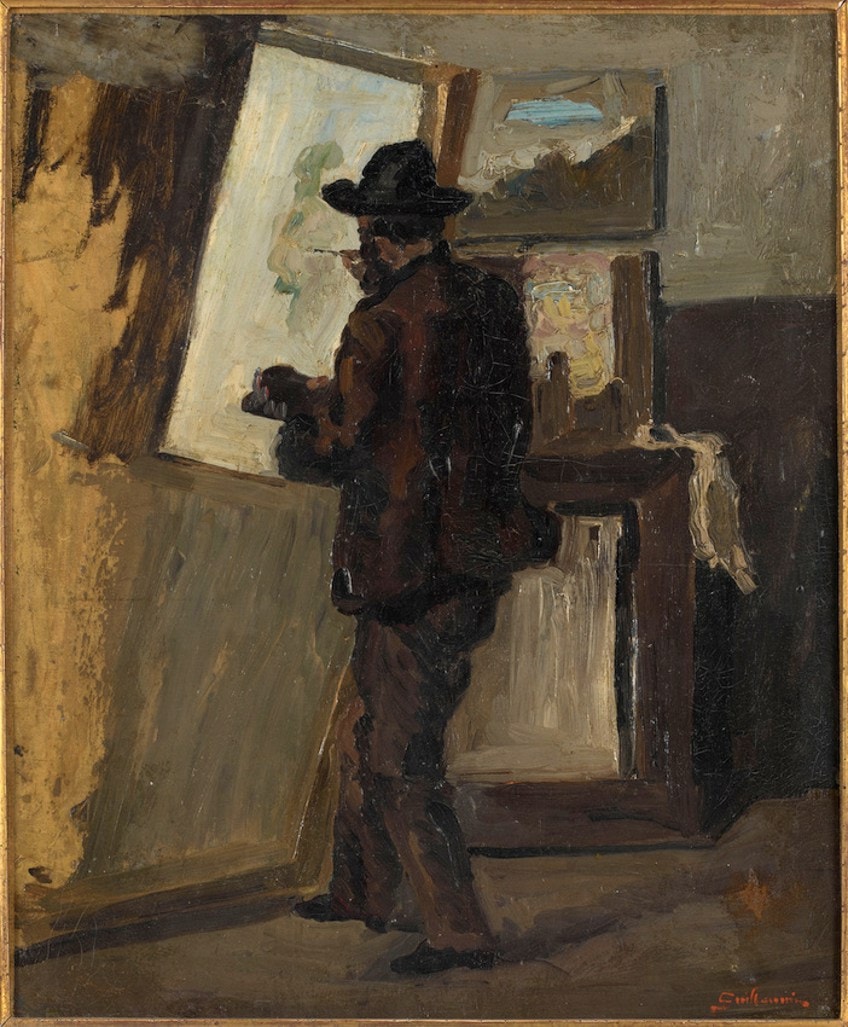
From the beginning of the 1860s, Pissarro’s work was selected to be shown in the Paris Salon. Although he was against everything the Salon stood for, he needed to participate in order to gain recognition. For this reason, all of Camille Pissarro’s early paintings were in adherence to the regulations of the Salon. In later years, once he had made a name for himself, he was able to be more experimental with his artworks.
In 1863, almost two-thirds of the art submitted to the Salon was rejected. This caused great upset in the art community.

Thus, Emperor Napoleon III ordered the creation of the Salon des Refusés, so that some of the artworks turned down by the Salon could still be displayed. Pissarro was one of the artists to display his works in this exhibition. The Salon des Refusés was filled with spectators, although the artworks displayed there received widespread criticism.
This was one of the first times an official exhibition displayed works of Impressionist art.
Throughout Pissarro’s early career, he always stated that he was a student of Melbye and Corot in the write-up that accompanied his artworks. This was not only to pay homage to his teachers but also in the hopes that spectators that enjoyed these artists would pay attention to his paintings too. The Paris Salon of 1868 was the first time he did not make any mention of his former masters. This was his way of declaring himself to the world as an artist in his own right.

During the late 1860s, Pissarro moved to the countryside near Paris with his wife, Julie Vellay, and first-born Lucien. It was here in Pontoise, and later Louvecienne, that he created some of his most famous paintings. Many of his artist friends, including Cézanne and Gauguin, stayed at his country homes seeking inspiration and mentorship.
Due to his gentle nature, many thought of Pissarro as a father figure in the art world.
Pissarro was forced to move his family to England at the outbreak of the Franco-Prussian War in 1870. During their year-long stay there, Pissarro would continue to paint landscapes, although this time of the English countryside rather than the French. Just as in France, his artworks were too progressive and so were not well received. However, he persisted in developing his art style, which in later years would come to be known as Impressionism.

Upon returning to France, Pissarro discovered that the majority of the artworks he had spent 20 years of his life creating had been destroyed during the war. For this reason, there are very few of Camille Pissarro’s early paintings still in existence. Luckily, this did not discourage Pissarro from creating many more artworks in his lifetime.
In 1873, Pissarro was one of the founding members of the Société Anonyme des Artistes, Peintres, Sculpteurs et Graveurs, a group of artists amongst which were Cézanne, Monet, and Renoir. Easily the oldest member of the group Pissarro was given a great deal of respect, yet never made himself into a self-appointed leader.
One of the primary reasons for forming the group was so that the artists could reject the Paris Salon and form their own exhibitions.
Between the years 1874 and 1886, the group held eight exhibitions to display their Impressionist art. However, the exhibitions were heavily criticized and did not prove to be very lucrative. Many of the more prominent members of the group such as Cézanne, Monet, and Renoir left the group after its fourth failed exhibition. Pissarro was the only artist who displayed his artworks in all eight exhibitions.

Ever the fan of change, Pissarro grew bored with Impressionism. In 1885, he met the artists Georges Seurat and Paul Signac who taught him new techniques. Thus, he turned away from the broad, bold brushstrokes of Impressionism and began experimenting with Pointillism. Pointillism consisted of placing separate dots of color next to one another to form an optical mixture from afar, rather than blending the colors together.
This technique produced more vivid, undiluted colors and came to be associated with Neo-Impressionism. Along with Seurat and Signac, Pissarro is credited as being a figurehead of the Neo-Impressionist movement.
Pissarro did not participate in Neo-Impressionism for all that long. He found it too systematic for him to fully express his creativity. However, upon returning to Impressionism, his works tended to be more intentional and skillful than previously. For this reason, many believe the Camille Pissarro artworks from the 1890s and early 1900s to be some of his best works.
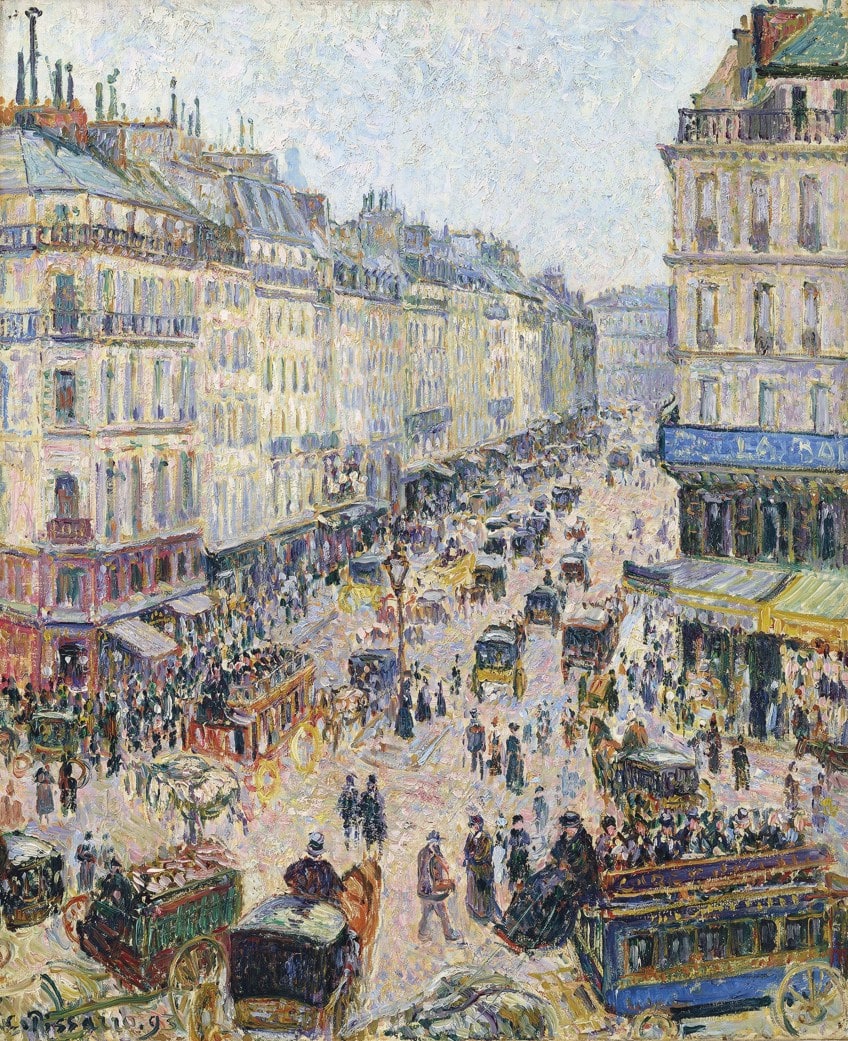
Pissarro never benefited financially from his artwork during his lifetime. He and his family often had barely enough money to survive as he only rarely managed to sell his paintings. During the 1880s, France also experienced an economic crisis. Their food supplies could not support their growing population causing huge price increases on staples such as bread.
In recent years, however, Camille Pissarro paintings sell for millions of dollars and can be found in many prestigious museums around the world.
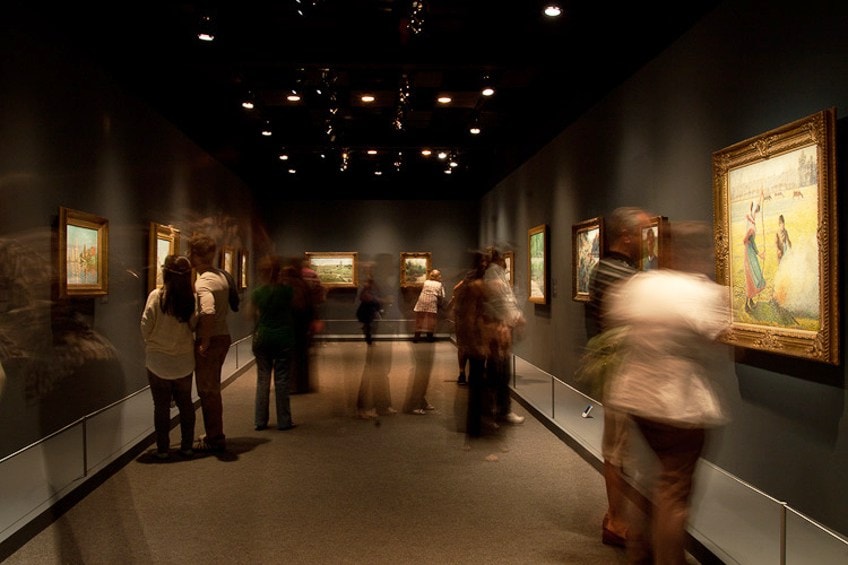
Artistic Characteristics of Camille Pissarro
Camille Pissarro’s early paintings are quite notably different from his later works. This is because he was constantly evolving and growing as an artist. Although Pissarro was typically a lot older than his artist peers, he retained a childlike inquisitiveness and was always open to experimenting with new techniques taught to him by other artists.
For this reason, you can often see characteristics of other famous artists in his artworks.

Themes
Camille Pissarro paintings are often easily distinguishable by pastoral themes. Pissarro enjoyed painting rural settings and the people that live in them. This passion began in his teenage years and early twenties while living in St Thomas.
We see pastoral imagery in paintings such as “Woman Carrying a Pitcher on Her Head” (c. 1854).

His love for painting the peasantry and rural life continued when he moved to France. For this reason, he spent a good deal of his time out in the countryside painting, even when living in Paris. Many of his most famous paintings come from the times in which he lived in various villages of the French countryside including Pontoise, Louveciennes, and Éragny. An example of this is The Harvest of Hay in Éragany (1887).
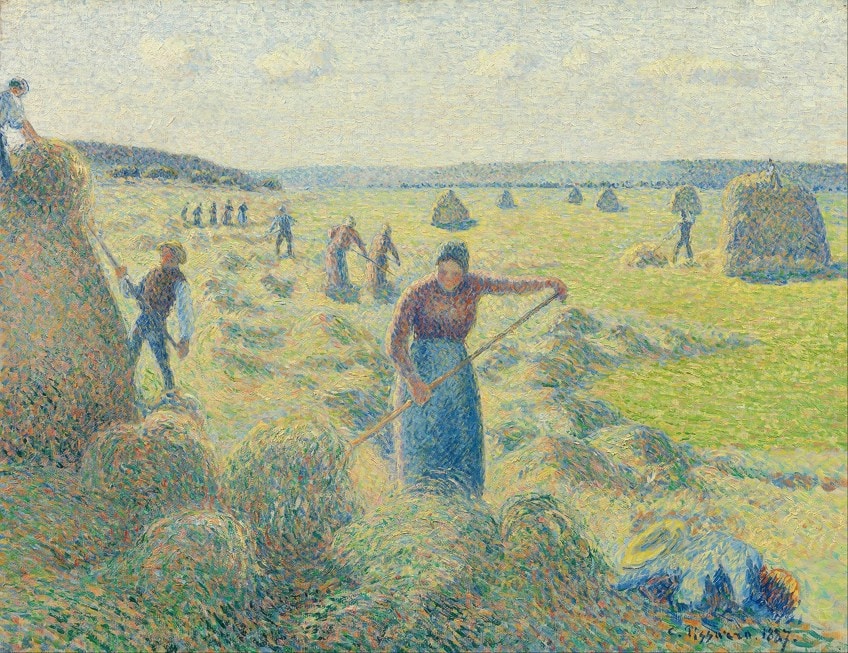
During his short stay in England, he also produced paintings of the English countryside, such as Lower Norwood (1871). Pissarro found beauty in the city as well as in the countryside.
Whilst living in Paris, he created paintings of the various “arrondissements”, particularly Montmartre.
Most of his cityscapes are a lot busier than his landscapes, showing the hustle and bustle typical of a metropolis. Some examples of his city scenes include Boulevard de Clichy (1880), and Avenue de l’Opera (1898).

Colors
In a quote by Cézanne, he explains how growing up in St Thomas made Pissarro a master of color. He said that by using only primary colors and the color which can be mixed from them Pissarro’s paintings were perfectly balanced.
Because he omitted harsh tones such as pure black and white, his artworks appear seamless and pleasant to the eye.
Even in paintings such as Landscape Under Snow, Upper Norwood (1871), one can see that the snow is not pure white, but instead contains pigments of yellow, blue, and brown. Like many other artists of the Impressionist movement, Camille Pissarro’s artwork often contained a limited color palette. This helped to keep the painting cohesive, as well as produce a painting that was calming, and not too overwhelming for the viewer.

Particularly, because many Impressionist paintings are highly textured, and so too much color and texture together would be overpowering. One could look at paintings such as Young Woman and Child at the Well (1882), to understand Pissarro’s limited color range.

For Pissarro, depicting light and shadows as he saw them at the moment was very important. Thus, many of his paintings are highly detailed and realistic. When examining paintings such as Chestnuts (1873), and Hyde Park (1890) one can see that Pissarro uses a blend of many colors to convey light and shadows.
This brings an element of movement and life to his artworks.

Techniques
Pissarro was a firm believer that artists, no matter what their style, should continually practice and improve their drawing skills. One can see from Pissarro’s paintings, particularly those containing architecture, that although his brushstrokes were chaotic the foundations of his paintings were always well thought out.
Art historians have found letters to his son Lucien, who was also an artist, urging him to practice his drawing in order to improve his paintings.
Another word of advice that Pissarro passed on to his protégé, was to paint everything that they saw at once. In other words, when painting a landscape, they should not paint the sky in its entirety before moving on to paint the grass and the trees. Instead, they should work on each aspect of the painting simultaneously in order to achieve a true likeness.
Pissarro enjoyed painting en plein air, and thus he would often finish paintings in a single sitting in order to make them as accurate as possible.
Finally, Pissarro was one of the figureheads of the Impressionist movement. And thus, like many Impressionist artists, he made use of very defined brushstrokes and texture. Using comma-like brushstrokes was a signature of his and can be seen in many of his paintings, such as Bank Holiday, Kew (1892). These add intrigue and movement to his pieces, breaking up flat spaces.

Neo-Impressionism
After practicing Impressionism for many years, Pissarro felt as though he was in an artistic rut. He believed his prayers to this had been answered when he met artists Georges Seurat and Paul Signac. They taught him about Pointillism, a technique commonly employed by Neo-Impressionists. Pointillism used small dabs of separate colors to achieve more vibrant, undiluted pigments. Seen from far away, they would appear as one blended color.
Pissarro experimented with Neo-Impressionism for four years before returning to Impressionism.
One of his biggest artistic challenges was trying to find a way in which to combine the pure tones created by using Pointillism with the unrestricted flow of Impressionism. He never truly found a way to do this. Although he found Neo-Impressionism to be too rigid for his personal liking, he was still able to create some beautiful paintings, such as Apple Harvest (1888), whilst participating in the movement.
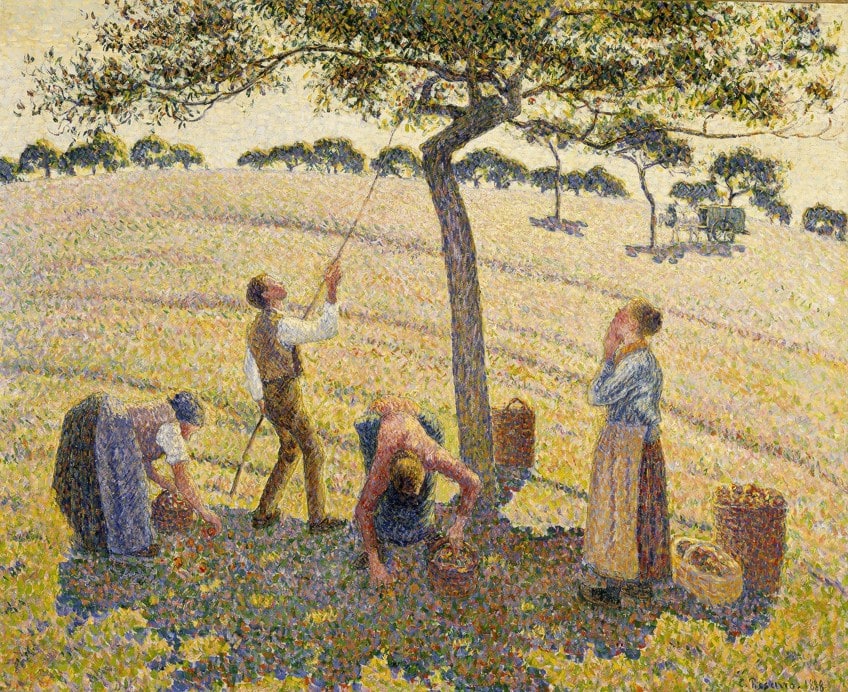
Important Camilla Pissarro Exhibitions
Camille Pissarro’s artwork did not make him a wealthy man during his lifetime and did not always receive praise from critics. However, he certainly developed a reputation as a dynamic artist and managed to display his paintings in many exhibitions during his career. Some of the more notable of which will be discussed below.
Salon des Refusés (1863)
It was a known fact amongst the artists of the time that getting your art displayed in the Paris Salon was no easy feat. The board of judges had very set ideas of what they would accept into the Paris Salon and rarely strayed from this. Pissarro showcased his paintings in a few Paris Salons, however, he felt as though he was simply complying with their regulations in order to gain recognition, not showing his true self.
In 1863, the Paris Salon refused the majority of the artworks submitted to it that year.

This caused a great deal of uproar from the art community. In order to remedy the situation, Emperor Napoleon III created another exhibition called the Salon des Refusés in which all the rejected artworks could be displayed. This was a momentous event in French history. Pissarro and some of his peers, including Cézanne, displayed their artworks in this exhibition.
However, overall, the artworks in the Salon des Refusés were highly criticized, as many of them were too progressive for the time.
Impressionist Exhibitions (1874 – 1886)
Pissarro, ever in opposition to the Paris Salon, believed that there should be a more open-minded alternative in which more experimental artworks could be exhibited. With this in mind he formed a group of 15 artists called the Société Anonyme des Artistes, Peintres, Sculpteurs et Graveurs. Within the group were acclaimed artists such as Cézanne, Monet, and Renoir, amongst others. In 1874, the first-ever Impressionist Exhibition was held.
Due to his leading role in organizing this exhibition, Pissarro came to be known as “the father of Impressionism”.

The group held eight Impressionist Exhibitions between 1874 and 1886, although they did not receive mainstream success and were not very profitable. For this reason, many of the more renowned artists left the group and returned to the Paris Salon. Pissarro, the most devoted to the group, was the only artist to display his artworks in all eight exhibitions.
Even though these exhibitions were not very lucrative and he often struggled to earn enough money, Pissarro never returned to the Paris Salon.
Camille Pissarro Artworks
Camille Pissarro was an avid artist from a young age. His passion for drawing and painting began when he was at boarding school in France and continued throughout his life. Although his paintings are what made him famous, Pissarro was vocal about his beliefs that all artists should practice their drawing skills regularly in order to truly understand form. Whilst working for his father in St Thomas, he spent every spare moment drawing. Thus, his collected works of both drawings and paintings are colossal.
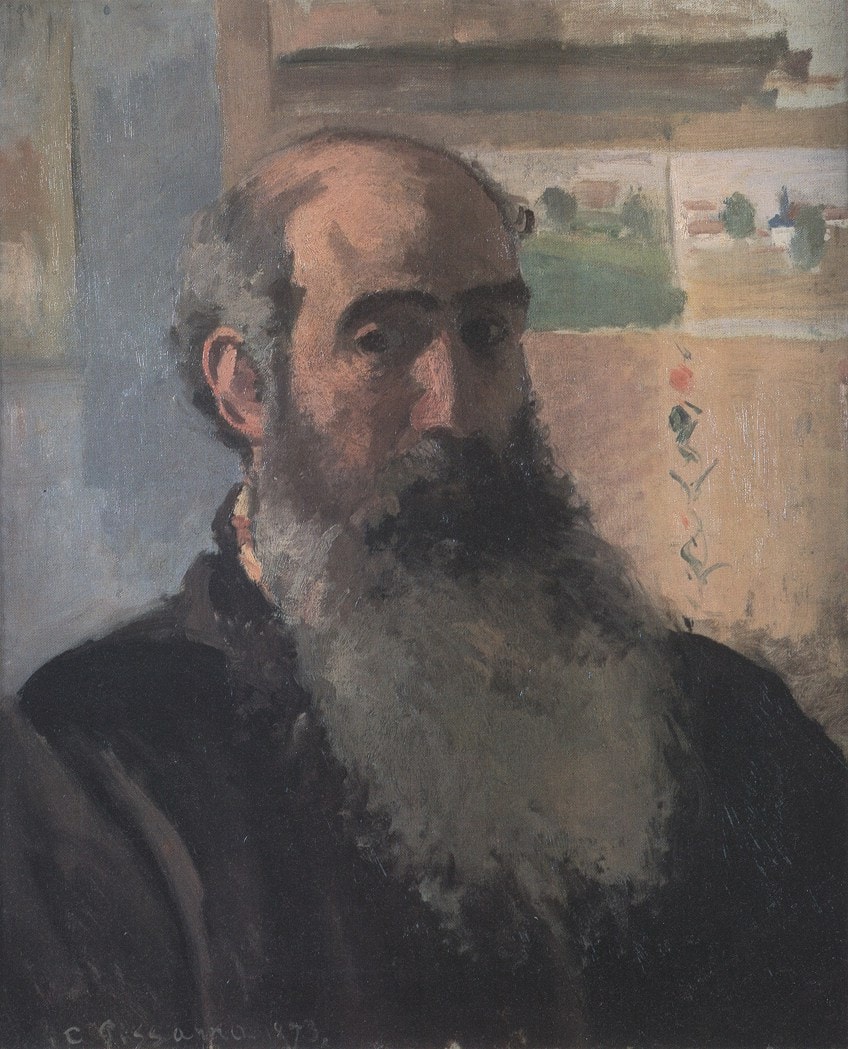
Camille Pissarro Drawings
Pissarro spent a great deal of his youth sketching his surroundings whilst in St Thomas, Venezuela, and France. His dedication to consistently bettering his drawing skills is evident in his paintings. Even in his most erratic paintings, it is clear that through all of his practice he developed a superb understanding of shape and form. He made innumerable drawings throughout his life; here are a few examples:
- Young Black Woman Sitting (c. 1855)
- La Père Melon au Repos (c. 1879)
- The Woods at L’Hermitage, Pontoise (1879)
- Pea Harvesters (c. 1880)
- Rue Damiette, Rouen (c. 1884)
- Village au Sommet D’une Colline (1890)

Camille Pissarro Paintings
Pissarro produced countless brilliant paintings throughout his career. The list below is but a small portion of them and showcases the various phases in his art style evolution. Many of the paintings are of rural landscapes and peasants at work.
These were Pissarro’s favorite subjects and he painted them whilst practicing Realism, Impressionism, and Neo-Impressionism.
| Title | Date | Dimensions | Medium |
| Paisaje tropical con casas rurales y palmeras | 1853 | 24.8 x 32.7 centimeters | Oil on cardboard |
| Two Women Chatting by the Sea | 1856 | 27.7 x 41 centimeters | Oil on canvas |
| Allée dans une forêt | 1859 | 81.5 x 65.8 centimeters | Oil on canvas |
| Jailaise Hill, Pontoise | 1867 | 87 x 114.9 centimeters | Oil on canvas |
| The Woods at Marly | 1871 | 45 x 55 centimeters | Oil on canvas |
| The Crystal Palace | 1871 | 47.2 x 73.5 centimeters | Oil on canvas |
| Hoarfrost | 1873 | 65.5 x 93.2 centimeters | Oil on canvas |
| Self-Portrait | 1873 | 55.5 x 46 centimeters | Oil on canvas |
| Red Roofs, Corner of a Village, Winter | 1877 | 54 x 65 centimeters | Oil on canvas |
| Washerwoman, Study | 1880 | 73 x 59.1 centimeters | Oil on canvas |
| Young Woman and Child at the Well | 1882 | 81.5 x 66.4 centimeters | Oil on canvas |
| Children on a Farm | 1887 | 20 x 26 centimeters | Oil on canvas |
| Haymaking, Éragny | 1887 | 65.5 x 81.3 centimeters | Oil on canvas |
| Two Young Peasant Women | c. 1891 | 89.5 x 116.5 centimeters | Oil on canvas |
| The Boulevard Montmartre on a Winter Morning | 1897 | 64.8 x 81.3 centimeters | Oil on canvas |
A Closer Look at Pissarro’s Paintings
Pissarro as an artist was constantly growing and bettering his skills. Throughout his vast collection of paintings, one can see that he was clearly not afraid to experiment with different techniques. Below are two of his more famous paintings, Hoarfrost (1873) and Haymaking, Éragny (1887). These are both incredible paintings in which one can see Pissarro’s evolution from Impressionism to Neo-Impressionism.
Hoarfrost (1873)
Hoarfrost (1873) is one of Pissarro’s most famous paintings. He debuted it at the first Impressionist Exhibition in 1874. At the time, this painting would have been revolutionary as paintings rarely showed landscapes with figures in them. Paintings with textured brushstrokes were also very uncommon.
Many elements in the painting are signatures of Pissarro’s personal art style, such as the subject matter, color palette, and use of visible brushstrokes.

Hoarfrost depicts some of Pissarro’s favorite subject matters, rural landscapes, and peasants. The painting is of a field in Pontoise, Pissarro’s home for a period of his life and the focus of many of his paintings.
In “Hoarfrost”, Pissarro uses paths and shadows to draw the viewer’s eye around the painting.
Hoarfrost is also an excellent example of Pissarro’s simple yet effective color palettes. Although he does not use many different colors, he is able to create highly realistic lighting and shadows. His pronounced brushstrokes also bring life to his shadows and prevent them from looking flat.
Haymaking at Éragny (1887)
Pissarro moved to Éragny, an area just outside of Paris, in 1884. Here he continued to paint landscapes of the countryside and peasants at work in the fields. It was during this time that he met Georges Seurat and Paul Signac who taught him about Pointillism, a technique used in Neo-Impressionist painting.
In Haymaking at Éragny (1887), one can see Pissarro’s first attempts at Pointillism. The painting is very bright and vibrant. It is made up of many dabs of color which do not mix with one another, yet from afar form an illusion of blended color.
Although he only practiced Neo-Impressionism for a few years, Pissarro was able to produce many beautiful paintings whilst participating in the movement.

Pissarro was very passionate about rendering realistic interpretations of light. He often studied how the different seasons of the year affected the colors of light. Although the range of color palettes in Haymaking at Éragny is still limited, the colors he uses are vastly different from paintings he made during autumn and winter. Haymaking at Éragny, also exhibits Pissarro’s preference for keeping the faces in his paintings vague. This is intended to make them ubiquitous, rather than specific to a particular person or area.
The anonymity Pissarro gave to his figures conveyed the respect he had for all peasants and laborers. He was a big believer in the nobility of manual labor and the virtues of rural life.
Book Recommendations About Camille Pissarro
This article aimed to give the reader some information about Camille Pissarro’s biography and artworks. However, given his long and plentiful life, it would be impossible to summarize such an influential man in just a few pages. Below are some book recommendations if you enjoyed learning about the life and works of Camille Pissarro and would like to find out more.

Camille Pissarro (1993) by Joachim Pissarro
Camille Pissarro (1993), published by Harry N. Abrams Inc, was written and illustrated by the great-grandson of Camille Pissarro himself. Not only does the author give Camille Pissarro’s biography, but he also talks the reader through Pissarro’s painting process in detail. This is the perfect book for an artist trying to get into the mind of Pissarro and who wants to emulate his process in their own works.
- Pissarro's great-grandson explores the artist's painting process
- A fully illustrated work that chronicles the events of Pissarro's life
- Describes Pissarro's work on innovative projects with other artists
Camille Pissarro: Impressions of the City and Country (2007) by Karen Levitov and Richard Shiff
Camille Pissarro: Impressions of the City and Country (2007) was published by The Jewish Museum. Although Pissarro never alluded to his culture in his paintings, he also never denied his Jewish heritage. This book focuses on Pissarro’s social and political beliefs and how they impacted his artworks.
It investigates recurring motifs in his works, such as peasants and laborers, and explains how he uses these themes to convey his reverence for the working class. In this book, the point is made that his “chaotic”, “messy” style in itself is an anti-bourgeois statement. Camille Pissarro: Impressions of the City and Country also includes Pissarro paintings from rare collections not often displayed to the public.
Camille Pissarro: The Studio of Modernism (2022) by Christopher Duvivier and Josef Helfenstein
Camille Pissarro: The Studio of Modernism (2022), published by Prestel, is a different take on many of the books published about the artist. The book focuses on the impact that Pissarro had on Impressionism and art as a whole. It discusses in detail his collaborations with artists such as Cézanne, Gauguin, Cassatt, Seurat, Signac, and many others. Camille Pissarro: The Studio of Modernism also includes actual letters written between Pissarro and these artists. As well as those written by them about Pissarro. Finally, it contains a detailed analysis of the effects Pissarro’s art had on the works of later artists such as Van Gogh.
- Traces Pissarro’s work in dialog with his fellow artists
- Reveals Pissarro's influence on works by other famous artists
- Includes pages of exquisite reproductions of works by Pissarro
Camille Pissarro, the artist, the mentor, and the revolutionary. He was a gentle soul who touched the hearts of his friends and family during his life and went on to inspire thousands of artists that came after him. Although he did not become wealthy from his art, he lived a rich life in which he never stopped doing what he loved. His legacy and the contributions he made to the art world will always be remembered.
https://www.youtube.com/watch?v=K0mtsP3lW08
Take a look at our Camille Pissarro paintings webstory here!
Frequently Asked Questions
Why Was Camille Pissarro So Important?
Camille Pissarro is often thought of as the father of Impressionism. There are many reasons for this. Firstly, he was one of the oldest artists to participate in the movement. As the oldest member of the group, he took on the role of mentor for the younger artists, such as Cézanne. Secondly, Pissarro was so passionate about Impressionism he organized the Impressionist Exhibitions and participated in all eight. Finally, he was one of the key figures of the Neo-Impressionist movement, along with Seurat and Signac.
What Is the Difference Between Impressionism and Neo-Impressionism?
Impressionism and Neo-Impressionism are fairly similar because Neo-Impressionism is an offshoot of Impressionism. However, there are key differences between the two art styles. Impressionism uses small, distinct brushstrokes to convey light and movement. Many Impressionist paintings were conducted en plein air and thus were spontaneous and completed in a single sitting. Neo-Impressionism, on the other hand, uses a technique called Pointillism, in which separate dots of color are utilized to create an illusion of blended color. This means that the colors are more vibrant and purer. Thus, Neo-Impressionism is a lot more methodical and does not allow for as much spontaneity as Impressionism. Neo-Impressionist paintings were also mainly created in studios as they required more time to complete.
How Did Camille Pissarro Influence Vincent van Gogh?
Pissarro was one of the original members of the Impressionist movement, meaning that his works inspired many other artists which followed. One of these artists was Vincent van Gogh. However, it is worth noting that Van Gogh inspired Pissarro as well. Van Gogh was an acquaintance of Pissarro’s whilst he was living in Paris. In fact, he nearly boarded at Pissarro’s country home for a period of time. Pissarro recognized Van Gogh’s talent and stated that he would rather go insane than leave the Impressionists behind.

Emma completed her Bachelor’s Degree in International Studies at the University of Stellenbosch. She majored in French, Political Science, and History. She graduated cum laude with a Postgraduate Diploma in Intercultural Communication. However, with all of these diverse interests, she became confused about what occupation to pursue. While exploring career options Emma interned at a nonprofit organization as a social media manager and content creator. This confirmed what she had always known deep down, that writing was her true passion.
Growing up, Emma was exposed to the world of art at an early age thanks to her artist father. As she grew older her interests in art and history collided and she spent hours pouring over artists’ biographies and books about art movements. Primitivism, Art Nouveau, and Surrealism are some of her favorite art movements. By joining the Art in Context team, she has set foot on a career path that has allowed her to explore all of her interests in a creative and dynamic way.
Learn more about the Art in Context Team.
Cite this Article
Emma, Littleton, “Camille Pissarro – Influential Impressionist and Neo-Impressionist.” Art in Context. June 8, 2022. URL: https://artincontext.org/camille-pissarro/
Littleton, E. (2022, 8 June). Camille Pissarro – Influential Impressionist and Neo-Impressionist. Art in Context. https://artincontext.org/camille-pissarro/
Littleton, Emma. “Camille Pissarro – Influential Impressionist and Neo-Impressionist.” Art in Context, June 8, 2022. https://artincontext.org/camille-pissarro/.


